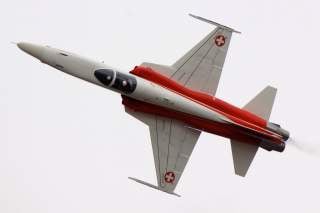America Wants More Stealth F-35s, New F-15X Fighters (And This Really Old Jet)
Why?
The U.S. Defense Department's $718-billion budget proposal for 2020 asks Congress to pay for hundreds of the latest warplanes, including F-35 stealth fighters, F-15X air-superiority fighters, CV-22 supply tiltrotors and MQ-25 tanker drones.
But one seemingly odd budget line in the Navy's portion of the request asks for $40 million to acquire 22 used F-5E/F Tiger fighters from Switzerland. The F-5s are at least 35 years old and unsophisticated. But they would play an important role in U.S. service.
The Navy plans to modify the F-5s with new avionics, data-links and radar-jammers, bringing them up to the latest F-5N standard. The 12-ton, radar-equipped, supersonic fighters then would serve as "adversaries" in the Navy and Marine Corps, playing the role of enemy fighters in war games and other training.
The Navy and Marines for decades have operated the nimble F-5 in the adversary role. “The design places particular emphasis on maneuverability rather than high speed, notably by the incorporation of maneuvering flaps,” according to the Navy.
The twin-engine jet boasts flight characteristics that are similar to many Russian-made MiGs. Most famously, F-5s stood in for MiGs in the 1986 movie Top Gun. “The F-5 offers an incredibly economic and proven solution for a range of threat presentations,” Tyler Rogoway explained at The War Zone.
By the early 2000s, however, the single-seat F-5Es and two-seat F-5Fs were wearing out. Luckily for the Navy and Marine Corps, in 2006 the Swiss air force was in the process of retiring many of its 1980s-vintage F-5s. The fighters had flown only a few thousand hours in Swiss service, making them functionally younger than the American F-5s were.
The Navy initially bought 36 Swiss F-5s, growing the adversary fleet to 44 planes. But the Marine Corps in particular demanded more adversaries. "Adversary capacity is the greatest issue in Marine Corps air‐to‐air training," the Corps stated in its 2018 aviation plan.
The problem for the Marines was that they're replacing around a hundred Harrier ground-attack jets with new F-35s that possess much greater air-to-air capability. In order to use their F-35s to their greatest potential, more Marine pilots must train to fight other planes.
"Annual fleet adversary requirements are expected to increase for transitioning squadrons from 6,400 air‐to‐air sorties in [fiscal year] '17 to 8,300 sorties per year in order to meet ... requirements in [fiscal year] '22," the Marines stated.
The service stated that it ultimately would like annually to perform 10,000 adversary sorties. But adversary training is “restrained by aircraft utilization and numbers of F‐5s assigned.”
Moreover, the Corps in 2018 worried that its current F-5s soon might wear out. "The F‐5 fleet is funded for life-limited components of upper cockpit longerons, wings, horizontal stabilator pairs and vertical stabilators," the service stated. The Corps expected the fixes to sustain all 44 F-5s until 2025 and 12 of the planes until 2028.
Adding F-5s would spread out a growing number of flight hours across more airframes, potentially extending the adversary fleet into the 2030s.
The Swiss air force in 2018 retired another 27 low-hour F-5s. It should come as no surprise that the Americans want to scoop them up. The used F-5s would cost the Pentagon just $1.8 million apiece, roughly a fiftieth of what a single F-35 costs.
The growing market for private adversaries might have compelled the Americans to hurry. “The Navy may have had its hand forced to some degree when it came to snapping up those planes as private contractors are gobbling up viable and economical surplus fighter jet airframes available on the international market at a startling pace as the demand for such services balloons,” Rogoway explained.
If in coming years the Navy and Marines decide further to expand and extend the adversary force, there are still 26 F-5s in Swiss service. The Swiss air force plans to replace the Tigers with a new type starting in 2025.
David Axe serves as Defense Editor of the National Interest. He is the author of the graphic novels War Fix, War Is Boring and Machete Squad.
Image: Creative Commons.


